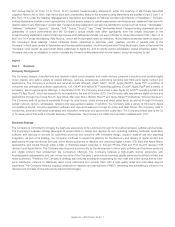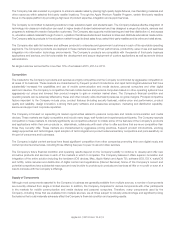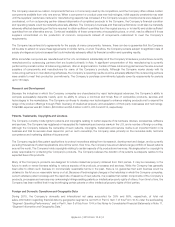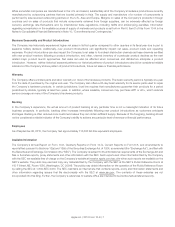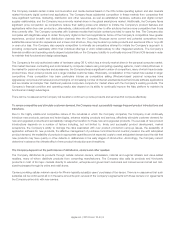Apple 2015 Annual Report Download - page 13
Download and view the complete annual report
Please find page 13 of the 2015 Apple annual report below. You can navigate through the pages in the report by either clicking on the pages listed below, or by using the keyword search tool below to find specific information within the annual report.The Company depends on component and product manufacturing and logistical services provided by outsourcing partners, many of
which are located outside of the U.S.
Substantially all of the Company’s manufacturing is performed in whole or in part by a few outsourcing partners located primarily in Asia.
The Company has also outsourced much of its transportation and logistics management. While these arrangements may lower operating
costs, they also reduce the Company’s direct control over production and distribution. It is uncertain what effect such diminished control
will have on the quality or quantity of products or services, or the Company’s flexibility to respond to changing conditions. Although
arrangements with these partners may contain provisions for warranty expense reimbursement, the Company may remain responsible to
the consumer for warranty service in the event of product defects and could experience an unanticipated product defect or warranty
liability. While the Company relies on its partners to adhere to its supplier code of conduct, material violations of the supplier code of
conduct could occur.
The Company relies on sole-sourced outsourcing partners in the U.S., Asia and Europe to supply and manufacture many critical
components, and on outsourcing partners primarily located in Asia, for final assembly of substantially all of the Company’s hardware
products. Any failure of these partners to perform may have a negative impact on the Company’s cost or supply of components or
finished goods. In addition, manufacturing or logistics in these locations or transit to final destinations may be disrupted for a variety of
reasons including, but not limited to, natural and man-made disasters, information technology system failures, commercial disputes,
military actions or economic, business, labor, environmental, public health, or political issues.
The Company has invested in manufacturing process equipment, much of which is held at certain of its outsourcing partners, and has
made prepayments to certain of its suppliers associated with long-term supply agreements. While these arrangements help ensure the
supply of components and finished goods, if these outsourcing partners or suppliers experience severe financial problems or other
disruptions in their business, such continued supply could be reduced or terminated and the net realizable value of these assets could be
negatively impacted.
The Company’s products and services may experience quality problems from time to time that can result in decreased sales and
operating margin and harm to the Company’s reputation.
The Company sells complex hardware and software products and services that can contain design and manufacturing defects.
Sophisticated operating system software and applications, such as those sold by the Company, often contain “bugs” that can
unexpectedly interfere with the software’s intended operation. The Company’s online services may from time to time experience outages,
service slowdowns, or errors. Defects may also occur in components and products the Company purchases from third parties. There can
be no assurance the Company will be able to detect and fix all defects in the hardware, software and services it sells. Failure to do so
could result in lost revenue, significant warranty and other expenses and harm to the Company’s reputation.
The Company relies on access to third-party digital content, which may not be available to the Company on commercially reasonable
terms or at all.
The Company contracts with numerous third parties to offer their digital content. This includes the right to sell currently available music,
movies, TV shows and books. The licensing or other distribution arrangements with these third parties are for relatively short terms and do
not guarantee the continuation or renewal of these arrangements on reasonable terms, if at all. Some third-party content providers and
distributors currently or in the future may offer competing products and services, and could take action to make it more difficult or
impossible for the Company to license or otherwise distribute their content in the future. Other content owners, providers or distributors
may seek to limit the Company’s access to, or increase the cost of, such content. The Company may be unable to continue to offer a
wide variety of content at reasonable prices with acceptable usage rules, or continue to expand its geographic reach. Failure to obtain the
right to make available third-party digital content, or to make available such content on commercially reasonable terms, could have a
material adverse impact on the Company’s financial condition and operating results.
Some third-party digital content providers require the Company to provide digital rights management and other security solutions. If
requirements change, the Company may have to develop or license new technology to provide these solutions. There is no assurance the
Company will be able to develop or license such solutions at a reasonable cost and in a timely manner. In addition, certain countries have
passed or may propose and adopt legislation that would force the Company to license its digital rights management, which could lessen
the protection of content and subject it to piracy and also could negatively affect arrangements with the Company’s content providers.
Apple Inc. | 2015 Form 10-K | 11


